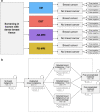Economic potential of abbreviated breast MRI for screening women with dense breast tissue for breast cancer
- PMID: 35482122
- PMCID: PMC9668927
- DOI: 10.1007/s00330-022-08777-5
Economic potential of abbreviated breast MRI for screening women with dense breast tissue for breast cancer
Abstract
Objectives: Abbreviated breast MRI (AB-MRI) was introduced to reduce both examination and image reading times and to improve cost-effectiveness of breast cancer screening. The aim of this model-based economic study was to analyze the cost-effectiveness of full protocol breast MRI (FB-MRI) vs. AB-MRI in screening women with dense breast tissue for breast cancer.
Methods: Decision analysis and a Markov model were designed to model the cumulative costs and effects of biennial screening in terms of quality-adjusted life years (QALYs) from a US healthcare system perspective. Model input parameters for a cohort of women with dense breast tissue were adopted from recent literature. The impact of varying AB-MRI costs per examination as well as specificity on the resulting cost-effectiveness was modeled within deterministic sensitivity analyses.
Results: At an assumed cost per examination of $ 263 for AB-MRI (84% of the cost of a FB-MRI examination), the discounted cumulative costs of both MR-based strategies accounted comparably. Reducing the costs of AB-MRI below $ 259 (82% of the cost of a FB-MRI examination, respectively), the incremental cost-effectiveness ratio of FB-MRI exceeded the willingness to pay threshold and the AB-MRI-strategy should be considered preferable in terms of cost-effectiveness.
Conclusions: Our preliminary findings indicate that AB-MRI may be considered cost-effective compared to FB-MRI for screening women with dense breast tissue for breast cancer, as long as the costs per examination do not exceed 82% of the cost of a FB-MRI examination.
Key points: • Cost-effectiveness of abbreviated breast MRI is affected by reductions in specificity and resulting false positive findings and increased recall rates. • Abbreviated breast MRI may be cost-effective up to a cost per examination of 82% of the cost of a full protocol examination. • Abbreviated breast MRI could be an economically preferable alternative to full protocol breast MRI in screening women with dense breast tissue.
Keywords: Breast neoplasms; Cost-effectiveness analysis; Magnetic resonance imaging; Mammography; Screening.
© 2022. The Author(s).
Conflict of interest statement
The authors of this manuscript declare no relationships with any companies, whose products or services may be related to the subject matter of the article.
Figures




References
-
- Riedl CC, Luft N, Bernhart C et al (2015) Triple-modality screening trial for familial breast cancer underlines the importance of magnetic resonance imaging and questions the role of mammography and ultrasound regardless of patient mutation status, age, and breast density. J Clin Oncol 33:1128–1135. 10.1200/JCO.2014.56.8626 - PMC - PubMed
-
- Sardanelli F, Podo F, Santoro F et al (2011) Multicenter surveillance of women at high genetic breast cancer risk using mammography, ultrasonography, and contrast-enhanced magnetic resonance imaging (the High Breast Cancer Risk Italian 1 Study): final results. Invest Radiol 46:94–105. 10.1097/RLI.0b013e3181f3fcdf - PubMed
-
- Sardanelli F, Aase HS, Álvarez M, et al (2017) Position paper on screening for breast cancer by the European Society of Breast Imaging (EUSOBI) and 30 national breast radiology bodies from Austria, Belgium, Bosnia and Herzegovina, Bulgaria, Croatia, Czech Republic, Denmark, Estonia, Finland, France, Germany, Greece, Hungary, Iceland, Ireland, Italy, Israel, Lithuania, Moldova, The Netherlands, Norway, Poland, Portugal, Romania, Serbia, Slovakia, Spain, Sweden, Switzerland and Turkey. Eur Radiol 27:2737–2743. 10.1007/s00330-016-4612-z - PMC - PubMed
-
- Sardanelli F, Boetes C, Borisch B et al (2010) Magnetic resonance imaging of the breast: recommendations from the EUSOMA working group. Eur J Cancer 46:1296–1316. 10.1016/j.ejca.2010.02.015 - PubMed
MeSH terms
LinkOut - more resources
Full Text Sources
Medical

